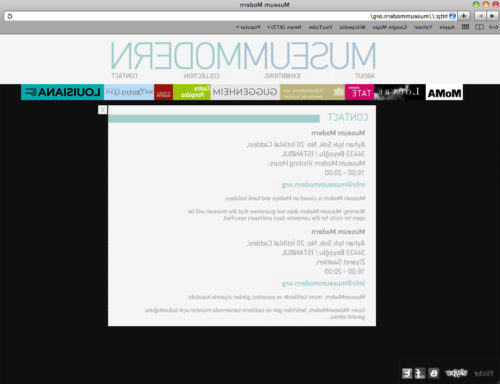MuseuMModern, Web art, domain name, software, 2010-2015
The work which starts with the idea of transforming the museum into an artwork, builds the entity of museum through internet’s language. Besides the pieces done in the exhibitions section of the work, the home page features the logos of major museums from the West. These logos direct you to the current websites of the museums when you click on them. When you want to move around these websites, you come across a setup which again directs you to www.museummodern.org. This way the museum greets you as a work of art, and creates a movement that points at the internet medium. The museum’s virtual presence and the illusion it creates using the the principal museum codes over the internet, reveals the tension between the physical and the objectless. www.museummodern.org highlights the very being of the illusion, rather than creating it. Virtual Reality is not only a simple perception form, but also a complex and unstable one. It has no focus. It often trades places and intertwines with the physical. The intertwinement brings forth absurd situations, and exactly at this point the relation between reality and fiction starts to form and defines itself through virtual reality. Using the absurd situations shaped by the points at which the physical and the objectless intersects, t!he museum draws attention to the shifts of meaning, content and function, and it makes an ‘ironic’ interpretation on the notions of museum and art.

The Artist’s Studio, 2011
www.museummodern.org 7/24 online artist’s studio
The artist’s studio carries with itself the statement of the ‘artist’ as an artwork. The internet users have the opportunity of watching the studio live for 24 hours over www.museummodern.com, with the help of software and two cameras placed in the studio. This way, the piece which opens the studio’s daily flow for surveillance on the virtual platform, brings into question the definition that is ‘studio as an artwork’, pushing away the idea of studio as a p!lace of production in the classical sense. In this piece displayed under the title of museum, the artist and his/her studio are now a displayed work of art. The artist’s studio which focuses on virtual entities, makes it possible to turn around the settled art categories, while emancipating itself from notions of reality. The piece called ‘the artist’s studio’, which is carried out in Museum Modern, brings forward such definitions belonging to the artistic system as who is an artist, how a ‘work’ of art operates. The piece can be viewed only in live stream, this way the artwork is free of its value as a commodity and the perception of time. The piece turns what belongs to the physical into consecutive moments on the virtual platform and makes it watchable in every corner of the world without a space restriction. Yes, the Studio and the artist are physically present in this work, but in this respect, as a form of access to the users, the internet presents an uncanny area. Nevertheless, it is verified that this museum which continues its virtual existence on the internet through online job applications, CVs sent, actually exists in the physical realm. This situation brings into question the issues of reality and representation, and under these circumstances the works focus on the language of internet as a medium.
Through the Looking Glass, 2012
The second exhibition on www.museummodern.org is created with reference to the chapter ‘Through the Looking Glass’ of Alice in Wonderland. Alice enters through the mirror, even though everything looks the same in it, this is an illusion. In the work called Through the Looking Glass, this story is associated with internet’s effect on perception. The work takes its name from a children’s story and warns us that we are faced with a similar situation to our belief in the stories that we listened to as a child. Just like we perceive what we read as a story, with childlike naivety it highlights the f!act that we should perceive what we view on the virtual platform in its own language. The inversion of reality and reality perception reflects the website as a mirror image. Everything in the museum are reorganised on the mirror upside down. Then we, as the ones before the monitor/screen, are inside the mirror.
The work which points out to questions such as what is true information on the internet, how we access it, presents this to us with a search button. This button directs the user to google. The main issue this approach brings forward is the interrogation of blind faith in virtual information. ‘Through the Looking Glass’ invites the users of the website to a kind of examination. What is the information that is presented to us, and should we really accept these without questioning them and assume that they are true. How should we evaluate new r!ealities and what kind of opinion on reality should we develop. What is present in the museums included in the work appears on the home page upside down, and asks how and by whom the construction of information in the artistic field is shaped. In this context, the piece is linked to today’s reservoir of knowledge and history writing.











